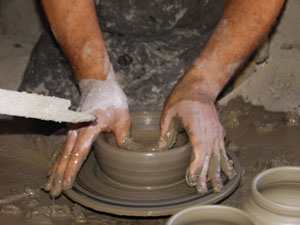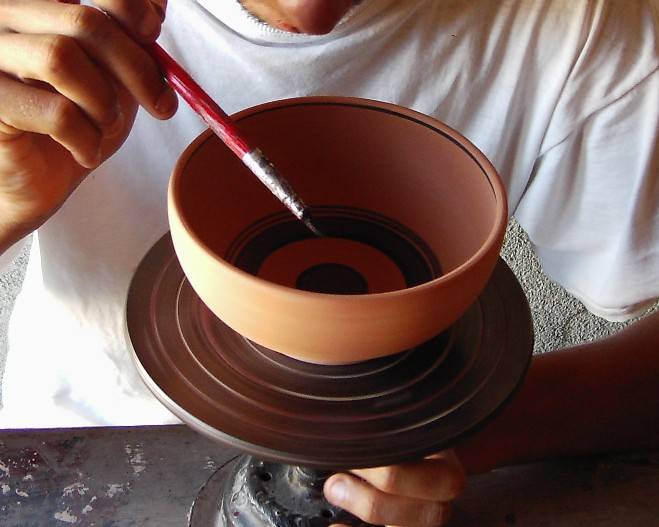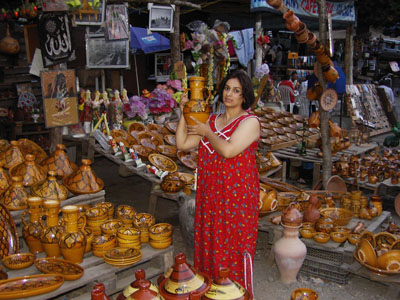The story of pottery goes back to 3000 years ago, some pieces of Berber Pottery were found in some areas of North Africa. That shows the age of culture, the ancient civilisation and the pure fascination of presence of the Berbers in North Africa.
I will be explaining about the Berber Pottery only from the year six hundred and seventy of our era. This period coincides with the creation of the town or Kairouan, first Muslim city in North Africa, and symbol of the definitive triumph of the Muslim-Arab invasion. From this date, until the fifteenth century, all the basic principles of civilization would come uniquely from the Orient.
The middle of that century would see a flotilla of nomadic invaders, sent by the Caliph of Cairo, surge upon the oriental Berbers. This was to be an event of capital importance which would change the face of Algeria. Nevertheless, the series of invasions which were to follow, would change the source of the principles, guiding the development of civilization which would, in future, come from the west.
 A complex art was to be born. Spanish and Moresque influences would supplement and enrich existing themes, eventually supplanting them, for over four centuries, until the Turkish domination which was to reinstate the initial East-West trend.
A complex art was to be born. Spanish and Moresque influences would supplement and enrich existing themes, eventually supplanting them, for over four centuries, until the Turkish domination which was to reinstate the initial East-West trend.
Berber art would enrich itself through its exposure to Turkish notions, and the Turks themselves would likewise benefit from the experience. This was to throw a new light upon the gray areas concerning the relationships in African Art.
Pottery is not in fact a profession, although it is generally thought of as such. This is one of the tasks falling to the mistress of the house, together with the preparation of wool. Logically, the spindle can be used equally well to produce clothes as it can to produce earthen-wear plate. The original production of pottery was very much a family concern, and it was later when it would be exchanged between neighbours and friends. A saying of the Aurès is that “clay, source of the world belongs to woman”. This explains why the task of organizing and decorating the home, its terrace, garden, balconies and workplaces, is the prerogative of women.
Potters continue to work with careful attention to detail, deeply affected by their belief in the symbiotic reciprocity of the fertile earth and feminine nature in life-giving harmony.
Pottery is the product of essential physical forces: The interplay of fire, earth and that vital element, water. These symbolic elements link pottery to mysteries forces which whisper of secrets and forbidden knowledge.
As spring bursts forth, the first piece of pottery to be worked would often be a votive lamp, made and dedicated to a holy protector. Each stage of work would follow a precise ritual, eventuality leading to the final liturgy. The firing would be done in a careful and almost reverential manner.
Thus the work of potter is untied with the world of mystery in which it is enveloped. Pottery carries with it imprints of immemorial traces stamped upon the daily life of centuries, with a skill known only to woman and jealously protected by her. Her secrets are locked within a pottery which will receive eternal visual homage.
Production of the clay for pottery follows the rhythm of the seasons, taking account of agricultural commitments and exploiting the available workforce in the fields. The craft of the potter is largely dependant on available day deposits, which have a direct consequence on the quality of the finished pottery.
Clods of clay are dug and collected, then crushed and put out to dry in the sun. The potters then work carefully to remove all impurities from the clay. Once this has been done, the clay is soaked in a bath of still water carefully avoiding any stirring, as this could provoke the formation of air bubbles, and increase the risk of the finished work cracking during the firing process.
The following day, the clay paste is thoroughly kneaded to increase its plasticity, and in order to minimize the risk of breakage at high temperatures, a cleaning agent made of old pottery powder is incorporated. The substance is sifted well a d worked into the day in a proportion of one third. The clay is ready to work only when it is supple and malleable without being sticky.

The operation takes time, and various stages are necessary in order to allow the artifacts, particularly when they are large, to dry. This avoids pieces collapsing from the successive application of glaze.
The completed piece is left to day for a period which varies depending on the season and climate, but it is usually preferable to place the item in a shady corner where it will take a little longer to dry, as this minimizes the possibility of fissures often caused through a too rapid process.
The decoration of the product will, of course, depend on its final purpose. Cooking utensils are rarely decorated, apart from a few incisions or use of relief, usually purely functional. Storage jars and plates for rolling couscous are soberly decorated, but their modelling and finishing is carried out meticulously.
Crockery for the family dresser, and for guests, naturally receives special treatment. Traditional potters use a palette of natural colours drawn from products such as white clay, rich in kaolin, and ochre-red clay, rich in ferric-manganese oxides. Designs are inspired by plants like the wild pistachio, but violets and juniper are still often used. The decorated products are then varnished using resins, and tinted using natural colourings.
The artisan’s tolls are few. A goat-hair paintbrush, together with a small ball of clay, a tuft of wool used to spread the background colours, a scrap of leather to give a smooth finish, and a rock splinter to dissolve the black colorant. The part to be decorated is covered with white or red ochre. Working completely freehand, triangles and lozenges appear as if by magic at the gifted fingertips of the artisan, who has to this day preserved intact all her patience and skill to offer us a product of rare beauty.
 Azazga, Ait Kheir, Maatkas and Bounouh are the four principle sites where the full range of kabyle pottery is represented. The pottery of Kabylia illustrates the mastery of man over natural element, which he learned to exploit to produce for himself objects of both functional and aesthetic value.
Azazga, Ait Kheir, Maatkas and Bounouh are the four principle sites where the full range of kabyle pottery is represented. The pottery of Kabylia illustrates the mastery of man over natural element, which he learned to exploit to produce for himself objects of both functional and aesthetic value.
New tools and techniques are brought to this magnificent handy work as the demand locally and throughout the world is way much higher than the supply. No plate, bowl, cup, bottle or pot, … is identical to the others. Their impaction gives them the handmade value and image. The brown and black are the essential and traditional colours for decoration; However, you may find other colours used mainly for commercial purposes satisfactorily to the demand and also improving in the world market and compete with the other finest handicrafts on the globe.
Reference: Some parts of the above text was inspired from "Algerian Handicrafts" By ANEP publishers
Note: To find out more about the Berber and Kabyle people and their handicraft/Pottery, just use any search engine, in typing the following keywords: Algeria handicraft, pottery, Berbers, Kabyle, etc.
